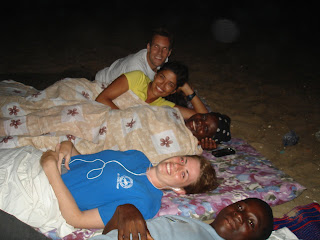This is a shot of the local men working on a community project. They were digging a ditch to redirect the flow of rainwater and prevent erosion of the road. All of the men from the area came out to help. The young men use the shovels and pick axes and the old men sit in the shade and supervise, to show their support.

Here is a photo from a visit to our friend Ayu's place, where we had a plain old pasta dinner that tasted fantastic. After dinner, Ayu san a Japanese song for us on her ukulele. I also got to try palm wine during our visit to her village, which left me sick to the stomach throughout the next day.

To celebrate the birth of a child, the local women gathered at one of the churches. Monetary donations are made to the church and they spend the day there singing and dancing. They dragged Marina out to join them. I hid behind the camera.

Our host father, Seth, was offered the position of village chief of a little village on the coast where his grandmother was born. He passed the position onto his younger brother, who we went to visit last weekend in his village.

There was a festival on in the village to honour past chiefs and town elders. They called out the names of these people and poured libation, then did some more singing and dancing.

Many of the villagers sleep on the beach, where they can enjoy the cool ocean breeze which also serves to keep the mosquitoes away. One night, we decided to do the same, but were woken up at midnight by rain and escaped to our rooms.

In the morning we woke up to the sound of drums and singing voices. A group of the local youth were going on a run together throughout the local villages. We're still not sure exactly why, but we were persuaded to join them, and ran along singing words we didn't understand and clapping along with the drums.

We also got to spend some time on the beach, swimming and playing soccer in the sand.

-Davis

















